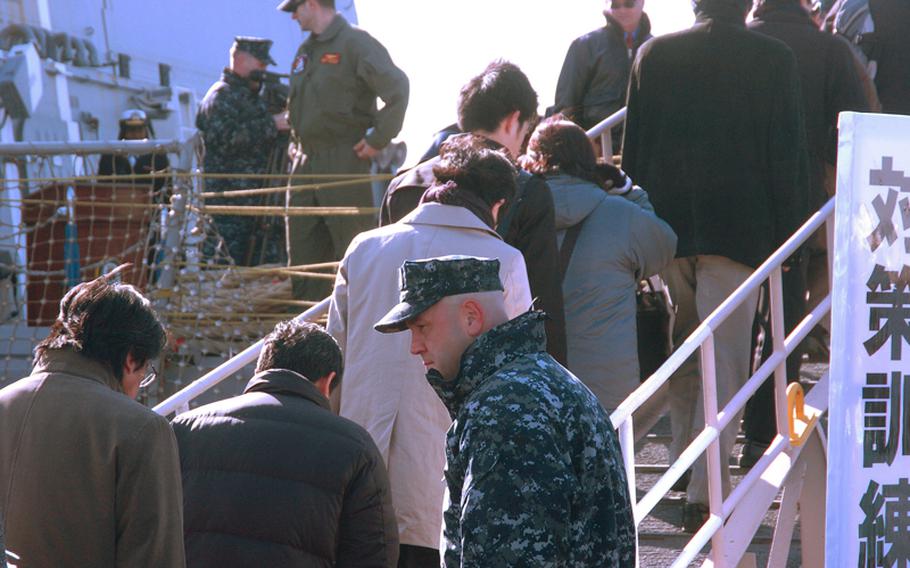
A USS Lassen sailor bows to each civilian during a disaster evacuation exercise at the Tokyo Lumber Pier on Feb. 3, 2012. The Lassen and the Army's USS Fort McHenry each helped evacuate dozens of people playing the roles of stranded commuters. About 10,000 people citywide took part in the drill, which was designed to improve upon the city's performance after millions of commuters were left stranded following the March 11, 2011 earthquake and tsunami. (Erik Slavin/Stars and Stripes)
YOKOSUKA NAVAL BASE, Japan — Army and Navy ships evacuated Japanese government employees from a Tokyo dock Friday as part of a massive citywide emergency drill.
About 10,000 people took part in the drill, which was in part a bid by the metropolitan government to overcome the logjam that occurred as public transportation ground to a halt in the aftermath of the March 11, 2011, earthquake and tsunami. The Japanese government estimated that 5 million people were unable to get home the night of the disaster, according to a Kyodo News report.
The drill took place under the assumption that a 7.3-magnitude earthquake struck at 10 a.m., centered in the northern part of Tokyo Bay.
At the Tokyo Lumber Pier in the Shinkiba neighborhood, the destroyer USS Lassen and the Army landing craft unit USS Fort McHenry each landed pierside and evacuated several dozen people playing the roles of stranded commuters. The exercise gave the U.S. military’s ships a chance to plan for an evacuation under various circumstances, including a situation where mooring at the otherwise intact pier might prove unwise.
“We discussed during the planning whether, if there was an earthquake, would it shift [the sea bottom] underneath,” Lassen spokesman Lt. j.g. Sean Brophy said.
The Lassen’s draft below the waterline is 36 feet; the pierside depth at the Tokyo lumber pier where the ship moored is about 39 feet. If the Lassen were unable to dock at the pier, it could send its rigid inflatable boats to shuttle evacuees, while the Lassen remained in deeper water, Brophy said.
The Lassen could evacuate up to 700 people for a short trip during a disaster, Brophy added.
The Fort McHenry is one of 10 landing craft utility boats that the Army has available to Japan during emergencies, officials said Friday.
The ships can evacuate about 250 people in 30 minutes, and can carry shipping containers converted into lounges for the evacuees while on board.
Soldiers from the 311th Expeditionary Sustainment Command at Mare Island, Calif., were flown in to operate the boats, partially to demonstrate how quickly they could get personnel to Japan if a disaster struck, said ship captain Chief Warrant Officer 4 Anthony Moschella.
Although it can’t evacuate as many people as a Navy destroyer, the landing craft utility boat’s draft is only about 8 feet.
“We can get into a lot of places the Navy can’t with this craft,” said Capt. Marco Ramos.
Elsewhere in Tokyo, the drill extended to railway stations and large businesses in the Shinjuku and Ikebukuro areas of Tokyo.
At Shinjuku Station, the staff of East Japan Railway Co. guided 130 participants from platforms while preparing emergency goods for 30,000 evacuees, according to the Kyodo report. The company was criticized for shutting down stations on the day of the March disaster, Kyodo reported.
The Japanese Maritime Self-Defense Force and Japanese Coast Guard also participated, officials said Friday.